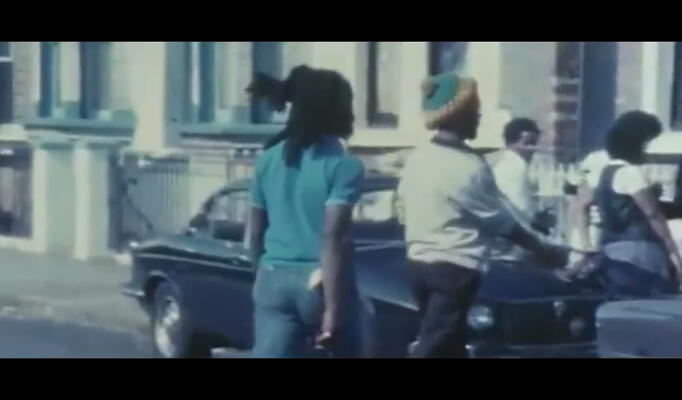
The Clash — (White Man) in Hammersmith Palais
"(White Man) in Hammersmith Palais" is a song and single by The Clash, self produced and first released as a 7" single, backed with similarly themed track "The Prisoner", in June 1978.
The song was later added to the American version of the band's debut album The Clash sandwiched between the single version of "White Riot" and "London's Burning".
Inspiration and composition
The song showed considerable musical and lyrical maturity for the band at the time and is stylistically more in line with their version of Junior Murvin's "Police & Thieves" as the powerful guitar intro of "(White Man) in Hammersmith Palais" descends into a slower ska rhythm, and was disorienting to a lot of the fans who had grown used to their earlier work. “We were a big fat riff group,” author Joe Strummer noted in The Clash's film Westway to the World. “We weren't supposed to do something like that.”
"(White Man) in Hammersmith Palais" starts by recounting an all-night reggae "showcase" night at the Hammersmith Palais in Shepherd's Bush, London that was attended by Joe Strummer, Don Letts and roadie Rodent and was headlined by Dillinger, Leroy Smart and Delroy Wilson. Strummer was disappointed and disillusioned that these performances had been more "pop" and "lightweight" similar to Ken Boothe's brand of reggae with Four Tops-like dance routines, and that the acts had been "performances" rather than the roots rock rebellion that he had been hoping for.
The song then moves away from the disappointing concert to address various other themes, nearly all relating to the state of Britain at the time. First giving an anti-violence message, then addressing the state of 'wealth distribution' in Britain, promoting unity between the Black and White youths of the country before moving on to address the state of the British punk rock scene in 1978 which was becoming more mainstream.
Included is a jibe at an unnamed group who wear Burton suits, taken by many to be The Jam (though in an NME article of the time, Strummer claimed the actual target was the power pop fad hyped by journalists as the next big thing in 1978) and the lyric concludes that the new groups are in it solely to be famous and for the money.
The final lines fret over the social decline of Britain, noting sardonically that things were getting to the point where even Adolf Hitler could expect to be sent a limousine in the unlikely event of flying into London.
The single was reissued in June 1978 with a different cover art.
This song was one of Joe Strummer's favorites, he continued to play it live with his new band The Mescaleros until his death and it was played at his funeral.
Critical reception
"(White Man) in Hammersmith Palais" helped The Clash assert themselves as a more versatile band musically and politically than many of their peers, and it broke the exciting but limiting punk mould that had been established by the Sex Pistols; from now on The Clash would be "the thinking man's yobs".
Robert Christgau recommended the single for "(White Man) in Hammersmith Palais" in his Consumer Guide, published by Village Voice, on 4 September 1978, and described the song as a must. Denise Sullivan of Allmusic wrote that "(White Man) In Hammersmith Palais" may have actually been the first song to merge punk and reggae."
In 2004, Rolling Stone rated the song as #430 in its list of the 500 Greatest Songs of All Time.
The The Clash — (White Man) in Hammersmith Palais clip can be downloaded for free and without registration.
| Size | 70.44 Mb |
| Resolution | 852x480 |
| Duration | 2:15 min |
| Format | avi |
| Artist | The Clash |
| Year | 1979 |
